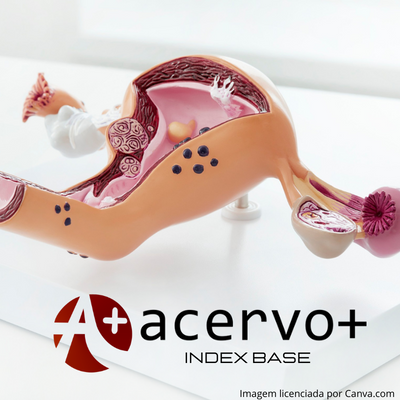Uma abordagem geral da Síndrome dos Ovários Policísticos: revisão de literatura
##plugins.themes.bootstrap3.article.main##
Resumo
Objetivo: Analisar as características da Síndrome dos Ovários Policísticos (SOP). Revisão bibliográfica: A SOP afeta mulheres de todas as raças e etnias em idade reprodutiva com taxas de prevalência tão altas quanto 21% relatadas em uma variedade de populações A etiologia da SOP é pouco compreendida, embora a SOP seja considerada uma característica genética complexa poligênica. A patogênese da SOP geralmente envolve a resistência à insulina, que leva a várias anormalidades cardiometabólicas (por exemplo, dislipidemia, hipertensão, intolerância à glicose, diabetes e síndrome metabólica), colocando as mulheres em risco aumentado de doença cardiovascular. Considerações finais: A SOP é o transtorno endócrino mais comum em mulheres em idade reprodutiva. Seu diagnóstico é baseado na presença de hiperandrogenismo clínico e/ou bioquímico e na disfunção ovariana definida como anormalidades menstruais (oligomenorreia anovulatória) ou/e a presença da morfologia do ovário policístico na ultrassonografia. O tratamento da SOP é baseado na mudança de estilo de vida com perda de peso para mulheres obesas. Além disso, podem ser administrados anticoncepcionais orais combinados e Metformina a fim de controlar os sintomas de hiperandrogenismo e resistência a insulina.
##plugins.themes.bootstrap3.article.details##
Copyright © | Todos os direitos reservados.
A revista detém os direitos autorais exclusivos de publicação deste artigo nos termos da lei 9610/98.
Reprodução parcial
É livre o uso de partes do texto, figuras e questionário do artigo, sendo obrigatória a citação dos autores e revista.
Reprodução total
É expressamente proibida, devendo ser autorizada pela revista.
Referências
2. AL WATTAR BH, et al. Clinical Practice Guidelines on the Diagnosis and Management of Polycystic Ovary Syndrome: A Systematic Review and Quality Assessment Study. J Clin Endocrinol Metab, 2021; 106(8): 2436-2446.
3. AMIRI M, et al. Effects of oral contraceptives on the quality of life of women with polycystic ovary syndrome: a crossover randomized controlled trial. Health Qual Life Outcomes, 2020; 18(1): 293.
4. AZIZI MK, et al. The effects of myo-inositol vs. metformin on the ovarian function in the polycystic ovary syndrome: a systematic review and meta-analysis. Eur Rev Med Pharmacol Sci, 2021; 25(7): 3105-3115.
5. CHE X, et al. Dietary Interventions: A Promising Treatment for Polycystic Ovary Syndrome. Ann Nutr Metab, 2021; 77(6): 313-323.
6. DABRAVOLSKI SA, et al. Mitochondrial Dysfunction and Chronic Inflammation in Polycystic Ovary Syndrome. Int J Mol Sci, 2021; 22(8): 3923.
7. DORETTO L, et al. Polycystic Ovary Syndrome and Psychotic Disorder. Front Psychiatry, 2020; 11:543.
8. GANIE MA, et al. Epidemiology, pathogenesis, genetics & management of polycystic ovary syndrome in India. Indian J Med Res, 2019; 150(4): 333-344.
9. KODIPALLI A, DEVI S. Prediction of PCOS and Mental Health Using Fuzzy Inference and SVM. Front Public Health, 2021; 9:789569.
10. KORIC A, et al. Polycystic ovary syndrome and postpartum depression symptoms: a population-based cohort study. Am J Obstet Gynecol, 2021; 224(6): 591.e1-591.e12.
11. KUMARIYA S, et al. Autophagy in ovary and polycystic ovary syndrome: role, dispute and future perspective. Autophagy, 2021; 17(10): 2706-2733.
12. LIM SS, et al. Lifestyle changes in women with polycystic ovary syndrome. Cochrane Database Syst Rev, 2019; 3(3): CD007506.
13. LIN AW, et al. Dietary and Physical Activity Behaviors in Women with Polycystic Ovary Syndrome per the New International Evidence-Based Guideline. Nutrients, 2019; 11(11): 2711.
14. MERVIEL P, et al. Impact of myo-inositol treatment in women with polycystic ovary syndrome in assisted reproductive technologies. Reprod Health, 2021; 18(1): 13.
15. MIMOUNI NEH, et al. Polycystic ovary syndrome is transmitted via a transgenerational epigenetic process. Cell Metab, 2021; 33(3): 513-530.
16. OSIBOGUN O, et al. Polycystic ovary syndrome and cardiometabolic risk: Opportunities for cardiovascular disease prevention. Trends Cardiovasc Med, 2020; 30(7): 399-404.
17. PEI CZ, et al. Pathogenetic analysis of polycystic ovary syndrome from the perspective of omics. Biomed Pharmacother, 2021; 142: 112031.
18. PENA VS, et al. Uma análise sobre as características da síndrome dos ovários policísticos: uma revisão de literatura. Revista Eletrônica Acervo Médico, 2022; 4, e9996.
19. RAJSKA A, et al. Metabolomic Insight into Polycystic Ovary Syndrome-An Overview. Int J Mol Sci, 2020; 21(14): 4853.
20. ROCHA AL, et al. Recent advances in the understanding and management of polycystic ovary syndrome. F1000Res, 2019; 8:F1000.
21. ROSENFIELD RL. Current concepts of polycystic ovary syndrome pathogenesis. Curr Opin Pediatr, 2020; 32(5): 698-706.
22. SADEGHI HM, et al. Polycystic Ovary Syndrome: A Comprehensive Review of Pathogenesis, Management, and Drug Repurposing. Int J Mol Sci, 2022; 23(2): 583.
23. SANCHEZ-GARRIDO MA, TENA-SEMPERE M. Metabolic dysfunction in polycystic ovary syndrome: Pathogenic role of androgen excess and potential therapeutic strategies. Mol Metab, 2020; 35: 100937.
24. SANTOS IK, et al. The effect of exercise as an intervention for women with polycystic ovary syndrome: A systematic review and meta-analysis. Medicine (Baltimore), 2020; 99(16): e19644.
25. STEEGERS-THEUNISSEN RPM, et al. Polycystic Ovary Syndrome: A Brain Disorder Characterized by Eating Problems Originating during Puberty and Adolescence. Int J Mol Sci, 2020; 21(21): 8211.
26. STENER-VICTORIN E, et al. Animal Models to Understand the Etiology and Pathophysiology of Polycystic Ovary Syndrome. Endocr Rev, 2020; 41(4): bnaa010.
27. SZCZUKO M, et al. Nutrition Strategy and Life Style in Polycystic Ovary Syndrome-Narrative Review. Nutrients, 2021; 13(7): 2452.
28. TEEDE HJ, et al. Recommendations from the international evidence-based guideline for the assessment and management of polycystic ovary syndrome. Hum Reprod, 2018; 33(9): 1602-1618.
29. THACKRAY VG. Sex, Microbes, and Polycystic Ovary Syndrome. Trends Endocrinol Metab, 2019; 30(1): 54-65.
30. WOLF WM, et al. Geographical Prevalence of Polycystic Ovary Syndrome as Determined by Region and Race/Ethnicity. Int J Environ Res Public Health, 2018; 15(11): 2589.
31. ZHANG J, et al. Polycystic ovary syndrome and mitochondrial dysfunction. Reprod Biol Endocrinol, 2019; 17(1): 67.

